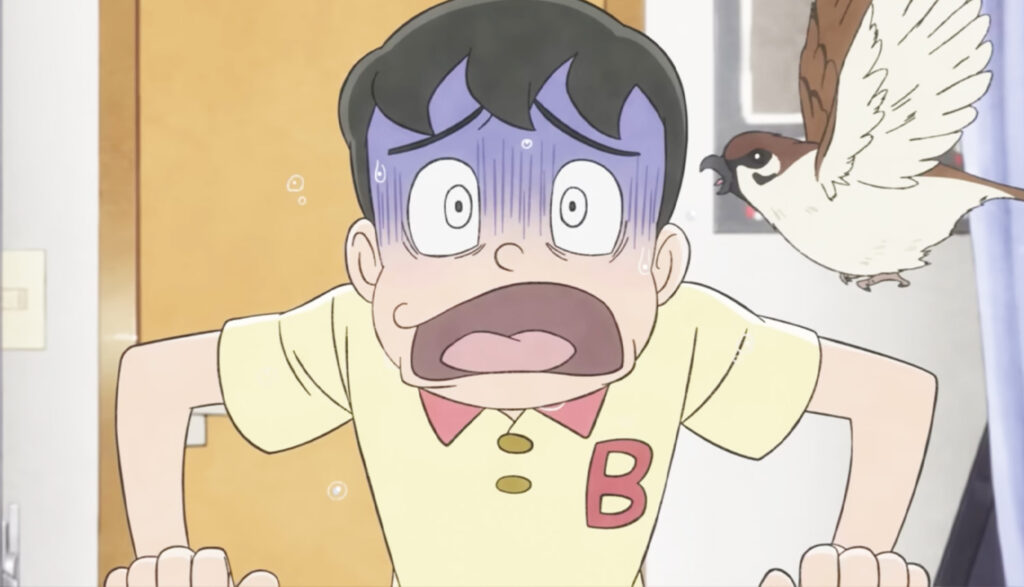
Doctor Who
The good Doctor’s been flitting around time, space and the BBC since 1963. Now he’s also a fixture in the US, toting his curiously British brand of sci-fi in his highly mobile TARDIS. Just how safe is this contraption?

The hands on the alarm clock spin furiously out of control. The room darkens. Brilliant shades of pink, blue and yellow erupt from the window.
Bon Namihira finds himself lying on the floor and concludes, “Obviously, I had a nervous breakdown from studying too hard.”
What other explanation could there be? After all, Bon is just an average teenager. He wakes up late for school. He’s neither popular nor unpopular. He always snags mediocre scores on his exams. In fact, Bon claims, “I actually like being average at everything.”
But Bon’s days of averageness are over.
While he relaxes at his friend Tetsuo’s house, Bon’s perception of reality transforms. As the boys chat, Tetsuo falls from a deadly height and dies. Before Bon can tell Tetsuo’s mother what has happened, reality warps before his eyes, and Bon finds himself sitting next to Tetsuo as if the incident had never happened.
“I am starting to lose my mind,” Bon fears.
But just as Bon is certain that he’s merely having a nervous breakdown, he meets a girl named Ream Stream and her sidekick, Buyoyon. He’s not going crazy, they tell him: Bon had witnessed time travel. Ream and Buyoyon are members of the Time Patrol. According to Ream, Time Patrol agents “travel through time and across the globe to save people from unfortunate deaths.” In fact, they may save anyone whose deaths are not “historically relevant.”
Unfortunately, Bon’s newfound knowledge of time travel poses a problem, and the Time Patrol agents conclude that Bon must be erased from existence. That is until they discover that Bon himself is historically relevant.
One option remains: Bon Namihira must abandon his average existence and join Time Patrol. Accompanied by Ream and Buyoyon, Bon goes everywhere from 1500 B.C. Crete to 1945 Okinawa to save innocent lives.
Based on Fujiko Fujio’s manga series, Time Patrol Bon, Netflix’s T • P Bon features everything you might expect from a teen-targeted anime.
On Netflix, viewers can choose between watching the show with English subtitles (listening to the original Japanese) or using English dubbing. Regardless of which option viewers might choose, characters use profanity such as “h—” and “d–n.” Additionally, although the series is animated, the violence can be rather graphic. Blood drains from victims of sword slashes. Natural disasters destroy cities. And the fifth episode of Season One depicts an accused witch being tortured (via waterboarding) and is, ultimately burned at a stake.
Some episodes also feature references to non-Christian spiritual beliefs. For example, in episode three of Season One, a character bows to what he believes is a goddess, and in episode six a character asserts, “Whether I live or die is at the mercy of Buddha.” Occasionally, episodes feature nudity. In episode five of Season One, for instance, a woman’s bare breasts are seen, and in other episodes male characters are seen wearing no shirts or using small pieces of cloth to cover their critical regions.
I’d venture that some viewers may perceive T • P Bon’s content issues as less intense because of the show’s animated—rather than live-action—medium. Nevertheless, content issues like violence, profanity, nudity and false spirituality still appear in most episodes. If these elements are not sensitivities for your family, enjoy T • P Bon’s exciting time travel adventures. Otherwise, you won’t have to travel very far to find other time travel-based entertainment.
When Bon witnesses time travel powers that reverse his friend’s death, his life changes forever.
A character falls from a tall building, and he meets his demise with a loud splat. Blood gushes from the character. Another scene features a man slicing people with his sword, drawing blood. A menacing sea monster attacks frightened characters.
There are two uses of “h—.” A character wears a dress, and the “camera” ogles her legs.
There is a brief reference to Japan’s Great Kamakura Buddha statue and the Hokke sect of Buddhism.
Bon begins his Time Patrol apprenticeship by saving Mrs. Yamada from Typhoon Kathleen in 1947 Tokyo.
Characters discover an old woman passed out in a pile of rubble. A storm destroys a village. A grown man punches a school-aged child in the head.
A man drinks what appears to be a glass of wine. Characters use profanity such as “h—” and “d–mit.”



The good Doctor’s been flitting around time, space and the BBC since 1963. Now he’s also a fixture in the US, toting his curiously British brand of sci-fi in his highly mobile TARDIS. Just how safe is this contraption?

The Big Cigar’s protagonist, Huey P. Newton, founder of the Black Panthers, is suspicious of Hollywood. In that, Plugged In would agree.

Milo offers great messages about friendship and trying new things, and it’s free of most anything parents would find concerning.

People from all walks of life learn lessons from God Himself that will change their lives.